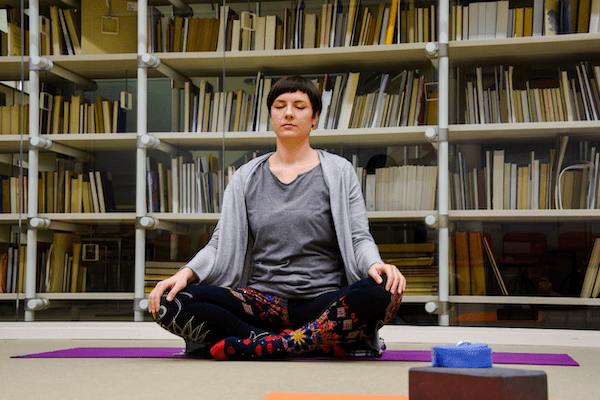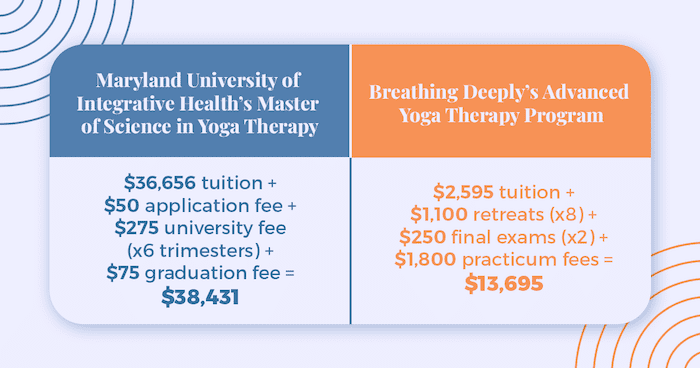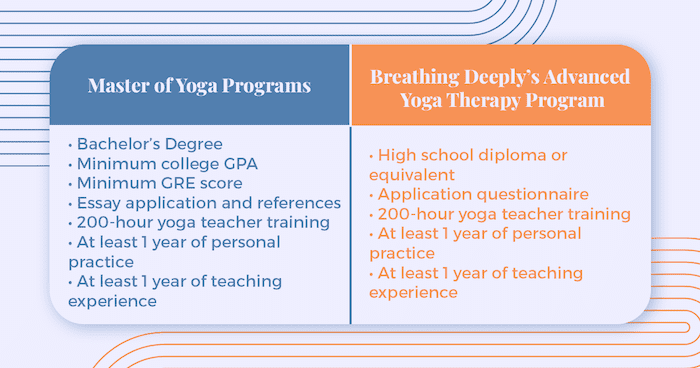
Yoga therapy is a growing field, with more yoga therapist jobs and career opportunities emerging all the time. But for those who are interested in working as yoga therapists, it’s important to know what education and training you’ll need to succeed in your career. In particular, many aspiring yoga therapists are asking if they’ll need a master’s in yoga therapy.
The answer will depend on what you’d like to do with your career. When I first became a yoga therapist, most of us earned a living by running our own private practices. As time has gone on, however, I’ve seen an increase in yoga therapists working in hospital programs, addiction centers, mental health departments, chiropractors’ offices, wellness centers, and school districts. There are even a few academic positions related to yoga therapy at colleges and universities.
In most cases, it’s enough to go through a reputable yoga therapy training program and become C-IAYT certified, the highest level of yoga therapy certification. It’s also significantly less expensive. But there are a few exceptions where a Master of Science in yoga therapy would be more beneficial. Keep reading to learn what educational path is right for you.
Table of Contents:
For many students, a yoga therapy training program makes the most sense for achieving their goals. As the founder and director of my own yoga therapy program, Breathing Deeply, I can speak from direct knowledge about how training such as ours often compares to a master’s in yoga therapy.
Master’s programs tend to be more costly than yoga therapy programs, which can be a major factor for many students to consider.
For example, at Maryland University of Integrative Health (MUIH), there’s a Master of Science in yoga therapy that the university itself estimates would cost $36,656 in tuition alone. That’s not including their $50 application fee, $275 university fee every trimester, or $75 graduation fee.

Soul of Yoga offers a program in collaboration with the California Institute for Human Sciences in which students can earn a master’s in integral health while gaining their yoga therapy certification as well. This program comes at a similar cost of $34,184.50 in tuition.
Most yoga therapy training programs have lower overhead costs, allowing them to offer much lower prices. At Breathing Deeply, students can complete our Advanced Program and become C-IAYT certified for just $13,695 total. This includes not only tuition, but also 4 week-long online retreats, 4 week-long residential retreats (including room and board), a practicum fee, and final exam costs.
Read our blog post about the cost to become a yoga therapist to learn more.
By operating outside of the college and university system, most yoga therapy programs do not need as many prerequisites and requirements.
At Breathing Deeply, even our highest program (the Advanced Program) only requires a high school diploma or equivalent. We have no required GPA, no application fee, and no essay application requirements—just a questionnaire to help us understand your background and experience.

By contrast, master’s programs typically require a Bachelor’s degree and minimum college GPA. Many also require you to pass the GRE, a standardized test that you must pay to take. Master’s programs can have a limited number of seats available and be highly competitive, making it more important to include a compelling essay application, list of references, and relevant work experience. You may even be required to interview to secure a spot.Whether you enroll in a yoga therapy program or at a college or university for a master’s in yoga therapy, it’s important to note that you are likely to need to have completed your 200-hour yoga teacher training and have at least one year of personal practice and teaching experience.
As mentioned in the previous section, you’re likely to be required to complete your 200-hour yoga teacher training beforehand whether you attend a yoga therapy training program or pursue a Master of Science in yoga therapy. The only difference is that a yoga therapy program may also offer a 200-hour yoga teacher training in house.
This may not seem like a major benefit at first, but most yoga teacher training programs are focused on teaching rather than yoga therapy. That’s great if you want to become a yoga teacher, but many students who want to become yoga therapists find that their 200-hour yoga teacher training is almost completely irrelevant to their goals, interests, and what they learn in a yoga therapy program.At Breathing Deeply, we’re pleased to offer a 200-hour yoga teacher training that is designed with yoga therapists in mind. Not only does it better prepare students for an education in yoga therapy, but we also allow students to seamlessly combine their yoga teacher training with our Foundations Program, which then integrates into the Advanced Program where students can become C-IAYT certified yoga therapists.
Many yoga therapy programs allow students to work at their own pace. This gives busier students more flexibility to juggle various responsibilities, while other students can work faster to finish sooner.
At Breathing Deeply, for instance, students can complete our Advanced Program in as little as 2 years. Coursework is self-paced and lessons are available 24/7 online.
By contrast, most master’s programs operate on strict semester schedules. Full-time graduate students usually need 2 or 3 years to complete a degree, but may take longer if they experience scheduling issues in a semester or need to retake a class.
The vast majority of yoga therapy jobs available today do not require a Master of Science in yoga therapy. More often, you’ll need to have completed yoga therapy or yoga teacher training, become certified, and gotten relevant work experience.
I’ve seen my own students go on to get jobs as yoga therapists at hospital programs (such as cancer centers or in the V.A.), addiction centers, mental health departments, chiropractors’ offices, wellness centers, and school districts. Of course, you can always open your own private practice as well.
The one career where a master’s in yoga therapy is necessary is in academia. Most college professors must have a PhD in their field (or a master’s degree if it is considered a terminal degree, meaning that their field typically does not offer anything higher than a master’s degree).
Although many yoga therapists don’t need to earn a Master of Science in yoga therapy, there are several benefits to this educational path that students should consider. Depending on your career goals, a master’s in yoga therapy may actually be necessary.
As mentioned above, if your ambition is to become a college professor in yoga therapy, then you will need a graduate degree. While most college professors need a PhD, fields that do not have many or any PhD programs are usually satisfied with a master’s degree.
Currently, there are limited options for earning a Master of Science in yoga therapy, which means you likely won’t need a PhD for some time to come in order to teach yoga therapy in college. At the same time, this means that there are very few positions available for professors of yoga therapy.
For those who are interested in the research side of yoga therapy, however, a master’s program may offer more academic research opportunities and support. For instance, Loyola Marymount University (LMU) offers graduate yoga therapy studies where one of the learning objectives is for students to be able to objectively assess research in the field of yoga and be able to present research findings at academic conferences. This skillset is unlikely to receive as much focus in a yoga therapy training program outside of the university setting.
For students hoping to earn other graduate degrees, a master’s in yoga therapy might better integrate with their educational goals. In order to become a licensed healthcare provider, for example, you’ll likely need to go to medical school.
It may be easier to transition into another graduate program at the same institution where you receive your master’s in yoga therapy. There may even be options to combine both degrees, or you might be able to earn your graduate degree in the medical field of your choice and simply add on a post-master’s certificate in yoga therapy.
That being said, you can also always go to medical school and then simply complete a yoga therapy training program. If you do not need a full academic degree in yoga therapy, this may be a faster and less expensive way to get the additional training you’d like to supplement your medical degree.
Depending on the program, students may have more access to mentored clinical experiences in conventional healthcare settings on or off campus through a master’s program. While many yoga therapy programs still offer significant clinical experiences, a master’s program may have more connections to healthcare centers within the university or local community.
Students who pursue a Master of Science in yoga therapy at Maryland University of Integrative Health (MUIH), for example, have access to mentored clinical experiences in MUIH’s Natural Care Center. If there are specific clinical experiences or working relationships that are critical to your career goals, you may want to look for master’s programs or yoga therapy training programs that can provide the access you want while in school.
Student loans are commonplace at colleges and universities, while other yoga therapy training programs may lack the infrastructure and resources to offer such loans. However, yoga therapy training programs tend to cost significantly less, which can lessen the need for student loans.
Such programs outside of academia may also offer flexible payment options to help address this need. This is why it’s important to do your research on financing options whether you’re looking at graduate programs or yoga therapy training programs.
Have more questions about yoga therapy education and training? Check our frequently asked questions below for guidance.
A yoga teacher teaches yoga to others. While many yoga teachers offer group classes, you can also offer private, one-on-one yoga sessions. Yoga teachers often use a particular style of yoga, such as Ashtanga yoga or hot yoga. In their classes, yoga teachers usually instruct students how to perform different asanas (poses), but they may also use pranayamas (breathing techniques), meditation, chanting, or yogic philosophies.
By contrast, a yoga therapist uses yoga to help treat specific health conditions, whether physical or mental. More often, yoga therapists work with clients one-on-one rather than in groups to provide individualized care. Yoga therapists must have a stronger understanding of health issues and complete more training in order to become certified.
Read our blog post on the differences between a yoga teacher and a yoga therapist to learn more.
Yoga therapy is used to apply yoga techniques to physical and mental health conditions. These can include everything from back pain to anxiety, depression, trauma and PTSD, chronic pain, arthritis, autoimmune diseases, rehab and healing, and more. The goal of yoga therapy is to help clients heal, and it can be used on its own or as part of a holistic health and wellness treatment plan.
The highest academic degree in yoga is a PhD. There are several options to earn a PhD in yoga abroad, and Vivekananda Yoga University (VaYU) started the first PhD program for yoga in North America in November 2022. Given the scarcity of PhD programs, however, many may consider a master’s in yoga therapy or yoga studies to be a terminal degree.
The highest level of yoga therapy certification in the world is C-IAYT, or certification through the International Association of Yoga Therapists.
If a yoga therapy training program is the right choice for you, I’d like to humbly offer Breathing Deeply’s programs for your consideration. We take pride in providing practical, ethical training for yoga therapists so more people will have access to quality yoga therapy.
For those who are just starting their journey, we have a 200-hour yoga teacher training program that can be combined with our Foundations program to get you started. Once you have completed this training or if you come to us with previous experience to meet these prerequisites, you can move on to our Advanced program and become a certified yoga therapist.
Learn more about our yoga therapy programs or get in touch by applying today.
Brandt talks about common questions applicants have about the Breathing Deeply Yoga Therapy Program. Tune in to get the full program details.
Friends in Yoga, The way we perceive the world is a curious thing. Is it on fire or getting better? Are we facing our challenges or shying away from them? Are we functioning from the present or some altered reality based on past experiences? The teachings tell us that reality is ultimately timeless. The vibration […]
There’s no doubt that yoga is gaining popularity, but you may be asking yourself, what is the most popular type of yoga? Where is each type most popular in the U.S. and around the world? And for those who are interested in trying it themselves, how can you practice these styles of yoga safely? For […]
Friends in Yoga, Sitting on a cushion, taking a yoga class, chanting a mantra before your morning coffee…no one would call these radical acts. They are small choices that we make to better ourselves. The motivation to practice often takes form by our desire to be healthier, to be more focused, to connect with our […]